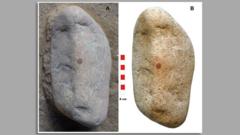The investigation led by researchers in Spain has revealed a striking development concerning Neanderthal capabilities, as they uncovered what is believed to be the oldest full human fingerprint on a stone, estimated to date back 43,000 years. The finding, made in the San Lázaro rock shelter in Segovia, showcases a pebble that bears a red dot painted as a nose, likely using red pigment, possibly ochre.
According to the study co-author María de Andrés-Herrero from the University of Complutense, the strategically placed pigment on the stone suggests a level of abstract thinking previously unassociated with Neanderthals. The excavation process began five years ago, with the pivotal moment occurring in 2022 when they found the stone buried under 1.5 meters of sediment attributed to Neanderthal use.
At first, the team was skeptical about their discovery. "It was really surprising to see a larger stone than what we had previously identified at the site, with a red dot in the center resembling a human face," stated Prof de Andrés-Herrero. After confirming the presence of ochre, collaboration with Spain's scientific police enabled a detailed analysis that revealed the human fingerprint, believed to belong to a male adult.
The study also highlighted a challenge: a lack of comparative references to other Neanderthal prints, making precise identification difficult. Spanish official Gonzalo Santonja remarked that this pebble not only constitutes the oldest painted portable art in Europe, but also stands as the sole known piece associated with Neanderthals.
Further emphasizing the significance of this discovery, Prof de Andrés-Herrero noted that the findings contribute to the ongoing discourse regarding the Neanderthals' symbolic capacities, marking the first known object displaying pigment in an archaeological setting. The fingerprint's context, being non-utilitarian, lends support to the theory that this dot was purposefully created for artistic intention.
Researchers propose that a Neanderthal may have chosen the stone for its unique features and deliberately applied ochre to leave a meaningful mark. As noted in their published research in the journal *Archaeological and Anthropological Sciences*, this pebble is thought to represent a visual symbol, potentially qualifying it as an early example of portable art. The implications of this study extend our understanding of Neanderthal society and their cognitive backdrop, reshaping much of what we previously believed about their cultural practices.
According to the study co-author María de Andrés-Herrero from the University of Complutense, the strategically placed pigment on the stone suggests a level of abstract thinking previously unassociated with Neanderthals. The excavation process began five years ago, with the pivotal moment occurring in 2022 when they found the stone buried under 1.5 meters of sediment attributed to Neanderthal use.
At first, the team was skeptical about their discovery. "It was really surprising to see a larger stone than what we had previously identified at the site, with a red dot in the center resembling a human face," stated Prof de Andrés-Herrero. After confirming the presence of ochre, collaboration with Spain's scientific police enabled a detailed analysis that revealed the human fingerprint, believed to belong to a male adult.
The study also highlighted a challenge: a lack of comparative references to other Neanderthal prints, making precise identification difficult. Spanish official Gonzalo Santonja remarked that this pebble not only constitutes the oldest painted portable art in Europe, but also stands as the sole known piece associated with Neanderthals.
Further emphasizing the significance of this discovery, Prof de Andrés-Herrero noted that the findings contribute to the ongoing discourse regarding the Neanderthals' symbolic capacities, marking the first known object displaying pigment in an archaeological setting. The fingerprint's context, being non-utilitarian, lends support to the theory that this dot was purposefully created for artistic intention.
Researchers propose that a Neanderthal may have chosen the stone for its unique features and deliberately applied ochre to leave a meaningful mark. As noted in their published research in the journal *Archaeological and Anthropological Sciences*, this pebble is thought to represent a visual symbol, potentially qualifying it as an early example of portable art. The implications of this study extend our understanding of Neanderthal society and their cognitive backdrop, reshaping much of what we previously believed about their cultural practices.



















